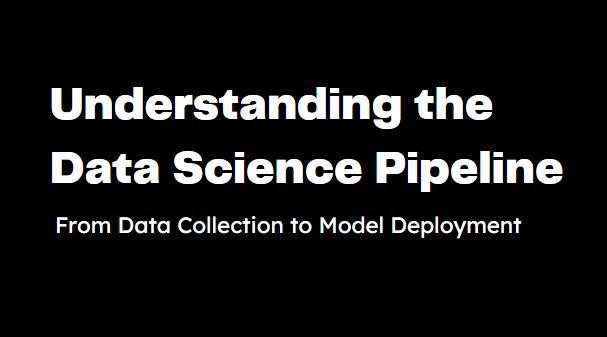
In the rapidly evolving field of data science, the journey from raw data to actionable insights is complex and multifaceted. This journey, often referred to as the data science pipeline, encompasses a series of steps that transform data into a powerful tool for decision-making. Understanding this pipeline is crucial for any aspiring data scientist, as it provides a structured approach to solving data-driven problems. In this blog, we’ll walk through each stage of the data science pipeline—from data collection to model deployment—and explore the key activities and tools involved in each phase.
1. Data Collection: The Foundation of Data Science
What It Is
Data collection is the first and arguably the most critical step in the data science pipeline. It involves gathering raw data from various sources, which can include databases, APIs, web scraping, sensors, or even manual entry.
Why It Matters
Without accurate and relevant data, the entire pipeline is at risk of producing flawed results. The quality of your data significantly impacts the accuracy of the subsequent analysis and modeling steps.
Tools and Techniques
- APIs (e.g., Twitter API, Google Maps API) for collecting data from web services.
- Web Scraping tools like BeautifulSoup or Scrapy for extracting data from websites.
- SQL for querying relational databases.
- Data Lakes like Amazon S3 or Hadoop for storing large datasets.
Best Practices
- Ensure data is collected from reliable and ethical sources.
- Validate the data to check for completeness and consistency.
- Store data securely, adhering to privacy regulations such as GDPR.
2. Data Cleaning: Preparing for Analysis
What It Is
Once data is collected, it often needs cleaning. Data cleaning, or data wrangling, involves identifying and correcting errors or inconsistencies within the dataset, such as missing values, duplicates, and outliers.
Why It Matters
Clean data is essential for accurate analysis. Unclean data can lead to incorrect insights and poor model performance, making this step crucial for the integrity of your entire project.
Tools and Techniques
- Python Libraries like Pandas and NumPy for data manipulation.
- OpenRefine for cleaning and transforming messy data.
- Imputation Techniques for handling missing data, such as mean substitution or using algorithms like KNN.
Best Practices
- Consistently document the cleaning process for transparency.
- Address missing data thoughtfully, considering the impact on the overall dataset.
- Use automated tools where possible to streamline the cleaning process.
3. Data Analysis: Uncovering Insights
What It Is
Data analysis involves exploring the cleaned data to identify patterns, relationships, and trends. This step is often exploratory and may include various statistical techniques to understand the data better.
Why It Matters
Data analysis provides the foundational insights needed to inform the direction of your modeling efforts. It helps in understanding the underlying structure of the data and identifying key variables for modeling.
Tools and Techniques
- Descriptive Statistics to summarize data characteristics.
- Data Visualization tools like Matplotlib, Seaborn, or Tableau for visual exploration.
- Exploratory Data Analysis (EDA) using Python or R to identify relationships between variables.
Best Practices
- Start with simple visualizations to grasp the data’s structure.
- Be skeptical of outliers and investigate their causes.
- Use statistical tests to validate your findings.
4. Modeling: Building Predictive Power
What It Is
Modeling is the process of building algorithms that can predict outcomes based on the data. This step involves selecting appropriate models, training them on the data, and optimizing their performance.
Why It Matters
The model is the heart of any data science project. A well-trained model can provide valuable predictions and insights, while a poorly chosen or trained model can lead to incorrect conclusions.
Tools and Techniques
- Machine Learning Algorithms like Linear Regression, Decision Trees, Random Forest, and Neural Networks.
- Python Libraries like Scikit-Learn, TensorFlow, and PyTorch for model building.
- Hyperparameter Tuning using GridSearchCV or RandomizedSearchCV for optimizing model performance.
Best Practices
- Split your data into training and testing sets to evaluate model performance.
- Use cross-validation to ensure the model’s robustness.
- Regularly monitor for overfitting, where the model performs well on training data but poorly on unseen data.
5. Model Deployment: Bringing Models to Life
What It Is
Model deployment is the final step, where the trained model is put into production to make real-time predictions or drive automated decisions. This stage involves integrating the model into a business process or application.
Why It Matters
Deployment turns your model from a theoretical exercise into a practical tool that can drive business value. However, it also brings challenges like scaling, monitoring, and updating the model as needed.
Tools and Techniques
- Containerization tools like Docker for packaging and deploying models.
- Cloud Platforms like AWS, Azure, or Google Cloud for scalable deployment.
- APIs to allow other applications to interact with your model.
Best Practices
- Monitor model performance in real-time and adjust as needed.
- Ensure the model can scale to handle the required load.
- Implement version control to manage updates and changes to the model.
Conclusion
The data science pipeline is a comprehensive process that transforms raw data into actionable insights through a series of well-defined steps. From data collection to model deployment, each phase is crucial to the success of a data science project. By understanding and mastering this pipeline, data scientists can ensure that their work not only yields accurate predictions but also delivers tangible value to their organizations.
Whether you’re a beginner or an experienced data scientist, continually refining your approach to each stage of the pipeline will enhance your ability to tackle complex data challenges and drive impactful results.



